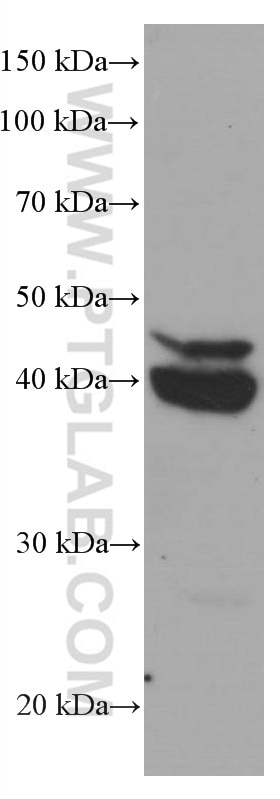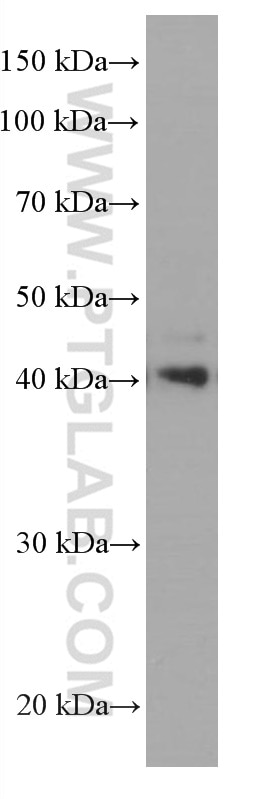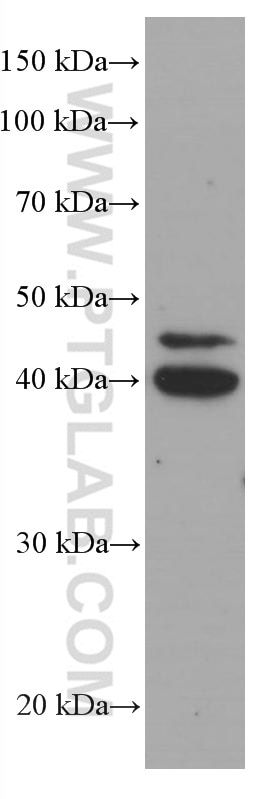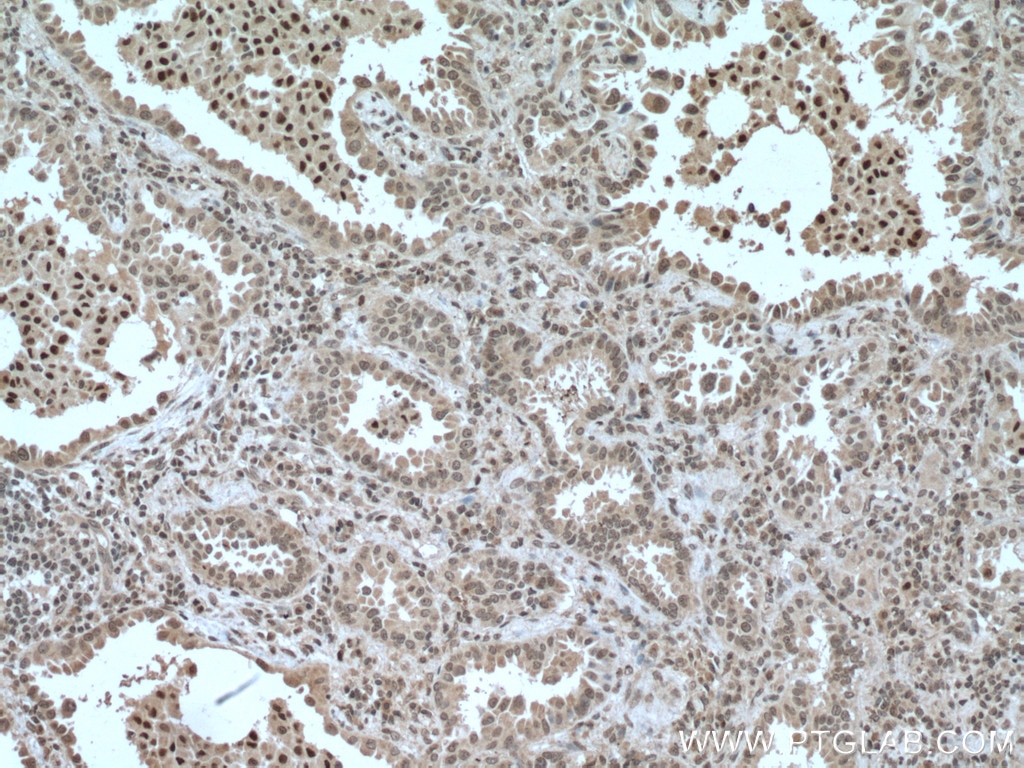Anticorps Monoclonal anti-CEBPB
CEBPB Monoclonal Antibody for IHC, WB, ELISA
Hôte / Isotype
Mouse / IgG1
Réactivité testée
Humain, rat, souris et plus (1)
Applications
WB, IHC, ELISA
Conjugaison
Non conjugué
CloneNo.
2B6E10
N° de cat : 66649-1-Ig
Synonymes
Galerie de données de validation
Applications testées
| Résultats positifs en WB | cellules HeLa, cellules HepG2, cellules L02 |
| Résultats positifs en IHC | tissu de cancer du poumon humain, il est suggéré de démasquer l'antigène avec un tampon de TE buffer pH 9.0; (*) À défaut, 'le démasquage de l'antigène peut être 'effectué avec un tampon citrate pH 6,0. |
Dilution recommandée
| Application | Dilution |
|---|---|
| Western Blot (WB) | WB : 1:1000-1:6000 |
| Immunohistochimie (IHC) | IHC : 1:150-1:600 |
| It is recommended that this reagent should be titrated in each testing system to obtain optimal results. | |
| Sample-dependent, check data in validation data gallery | |
Applications publiées
| WB | See 3 publications below |
Informations sur le produit
66649-1-Ig cible CEBPB dans les applications de WB, IHC, ELISA et montre une réactivité avec des échantillons Humain, rat, souris
| Réactivité | Humain, rat, souris |
| Réactivité citée | Humain, singe, souris |
| Hôte / Isotype | Mouse / IgG1 |
| Clonalité | Monoclonal |
| Type | Anticorps |
| Immunogène | CEBPB Protéine recombinante Ag20073 |
| Nom complet | CCAAT/enhancer binding protein (C/EBP), beta |
| Masse moléculaire calculée | 345 aa, 36 kDa |
| Poids moléculaire observé | 40-45 kDa |
| Numéro d’acquisition GenBank | BC007538 |
| Symbole du gène | CEBPB |
| Identification du gène (NCBI) | 1051 |
| Conjugaison | Non conjugué |
| Forme | Liquide |
| Méthode de purification | Purification par protéine G |
| Tampon de stockage | PBS avec azoture de sodium à 0,02 % et glycérol à 50 % pH 7,3 |
| Conditions de stockage | Stocker à -20°C. Stable pendant un an après l'expédition. L'aliquotage n'est pas nécessaire pour le stockage à -20oC Les 20ul contiennent 0,1% de BSA. |
Informations générales
CCAAT/enhancer-binding protein beta (CEBPB), also known as LAP, is a important transcriptional activator in the regulation of genes involved in immune and inflammatory responses. It specifically binds to an IL-1 response element in the IL-6 gene. NF-IL6 also binds to regulatory regions of several acute-phase and cytokines genes. It probably plays a role in the regulation of acute-phase reaction, inflammation and hemopoiesis. The consensus recognition site is 5'-T[TG]NNGNAA[TG]-3'. Functions in brown adipose tissue (BAT) differentiation By similarity. Regulates the transcriptional induction of peroxisome proliferator-activated receptor gamma (PPARG). CEBPb mRNAs possess alternative translation-initiation codons, which result in the formation of truncated forms of the protein. All major isoforms of CEBPB (38, 34, and 20 kDa) are expressed, with the 34 and 20kDa isoforms being more abundant in preovulatory follicles and further increased in corpora lutea (CL)(PMID:15647458).The truncated protein of 18 kDa (relative to the 30 kDa full-length protein that is known as LAP, or p30 CEBPb or liver-activating protein) lacks a transactivation domain,also known as LIP (p19 CEBPb or liver-inhibitory protein), can form homodimers or heterodimerize with other family members and, as it lacks the transactivation domain, can attenuate the transcriptional activation properties of the other isoforms.(10051447). Three variants ofCEBPBs have been detected in many cell types: a 46 kDa full-length liver-enriched transcription-activating protein (LAP1), a 42 kDa LAP2 and a 20-kDa liver-enriched transcription-inhibitory protein (LIP). These variants are the result of an alternative translation initiation due to a leaky ribosomal scanning mechanism.(PMID:18820298).
Protocole
| Product Specific Protocols | |
|---|---|
| WB protocol for CEBPB antibody 66649-1-Ig | Download protocol |
| IHC protocol for CEBPB antibody 66649-1-Ig | Download protocol |
| Standard Protocols | |
|---|---|
| Click here to view our Standard Protocols |
Publications
| Species | Application | Title |
|---|---|---|
Int J Biol Macromol CircDYM attenuates microglial apoptosis via CEBPB/ZC3H4 axis in LPS-induced mouse model of depression | ||
Int J Mol Sci Piperine Improves Lipid Dysregulation by Modulating Circadian Genes Bmal1 and Clock in HepG2 Cells. | ||
Stem Cell Res Ther The effects of BMMSC treatment on lung tissue degeneration in elderly macaques. |
Avis
The reviews below have been submitted by verified Proteintech customers who received an incentive forproviding their feedback.
FH Boyan (Verified Customer) (01-25-2019) | Good. It only works for human CEBPb protein, because the antigen of this antibody is targeting the N-terminus of the protein, which is not conserved in human and mouse.
|





